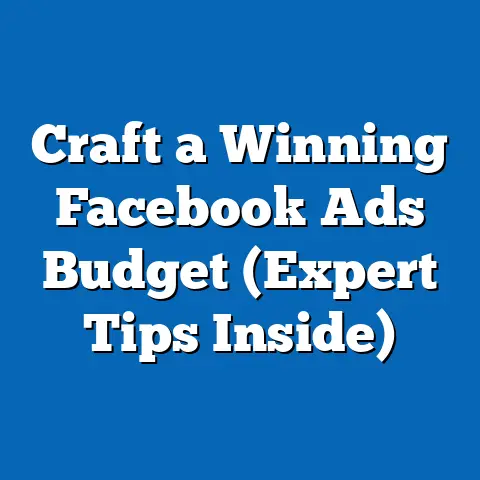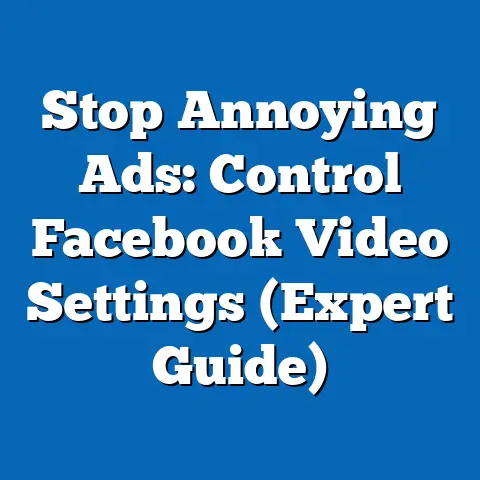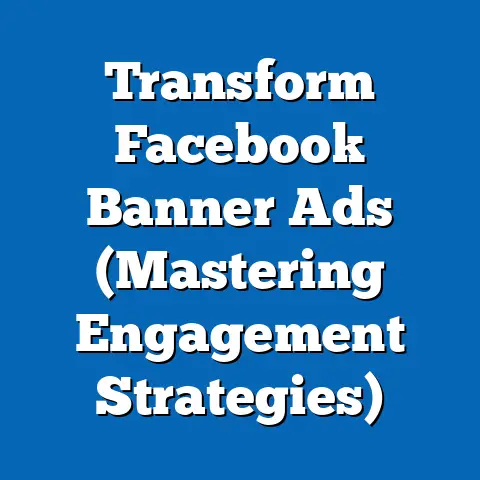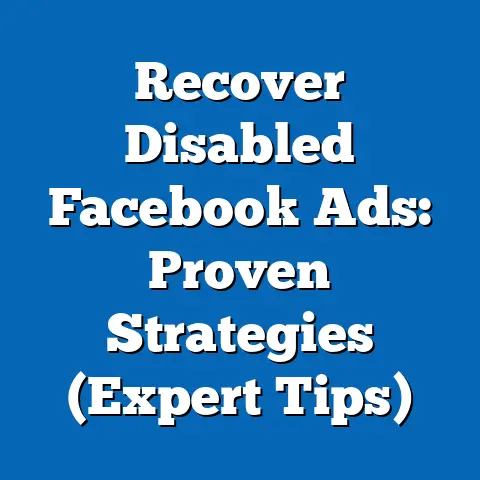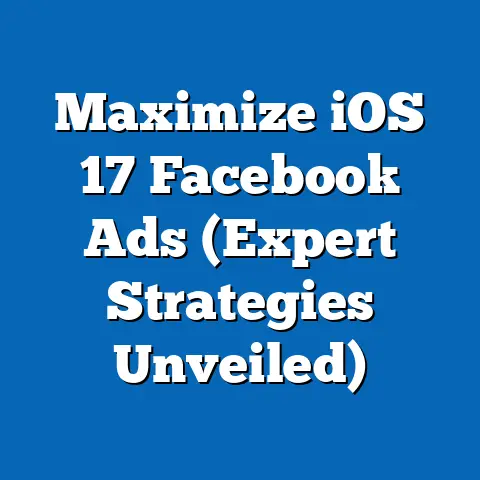Maximize Free Facebook Ads Credits (Strategic Secrets)
The digital marketing landscape is a constantly evolving beast, and staying ahead of the curve requires not only innovation but also strategic resource allocation. In this game, Facebook advertising stands out as a powerful tool, connecting businesses with billions of potential customers worldwide. What if I told you that you could tap into this potential without breaking the bank? That’s where free Facebook Ads credits come in.
I’ve spent years navigating the world of Facebook Ads, witnessing firsthand the incredible impact they can have on businesses of all sizes. From launching small startups to scaling established brands, I’ve seen how a well-crafted Facebook ad campaign can drive significant growth and build lasting brand recognition. But let’s be honest, advertising costs can quickly add up.
The concept of “durability” is crucial in online advertising. It’s not just about running a single, flashy campaign; it’s about creating consistent, well-strategized efforts that build momentum over time. Think of it as planting a seed – you need to nurture it consistently to see it blossom into a thriving plant. Facebook Ads, when used strategically, can be the fertilizer that fuels your business growth.
The good news is that Facebook often offers free ad credits, a valuable resource, especially for those just starting out or operating on a tight budget. Think of these credits as “seed money” for your marketing efforts. They allow you to experiment, learn, and optimize your campaigns without risking your own capital.
Section 1: Understanding Facebook Ads Credits
So, let’s dive in and demystify the world of Facebook Ads credits.
1. What Are Facebook Ads Credits?
Simply put, Facebook Ads credits are promotional funds that Facebook provides to advertisers. These credits can be used to pay for your advertising campaigns on the platform, allowing you to reach a wider audience and achieve your marketing goals without immediately dipping into your own budget.
Think of it as a “try before you buy” opportunity. Facebook wants you to experience the power of their advertising platform firsthand, and these credits are a way to incentivize you to get started.
How They Work:
- Application: Typically, you’ll receive a code or a direct credit to your ad account.
- Activation: You’ll need to add the code to your Facebook Ads Manager to activate the credit.
- Usage: As you run your ad campaigns, Facebook will deduct the costs from your available credit balance.
- Expiration: These credits usually have an expiration date, so it’s essential to use them within the specified timeframe.
Eligibility Criteria:
Eligibility for Facebook Ads credits varies depending on the promotion or offer. However, some common criteria include:
- New Advertisers: Facebook often offers credits to new advertisers to encourage them to start using the platform.
- Specific Business Niches: Sometimes, Facebook targets specific industries or business types with promotional offers. For example, they might offer credits to businesses promoting local events or supporting social causes.
- Partnerships: Facebook may partner with other companies or organizations to offer credits as part of a joint promotion.
My Experience:
I remember when I first started using Facebook Ads, I was hesitant to invest a significant amount of money without knowing if it would actually work. Luckily, I stumbled upon a promotional offer for new advertisers, which gave me a substantial amount of free credits. This allowed me to experiment with different ad formats, targeting options, and bidding strategies without the fear of wasting my own money. It was an invaluable learning experience that ultimately led to my success with Facebook Ads.
2. Types of Facebook Ads Credits
Not all Facebook Ads credits are created equal. Understanding the different types available is crucial for maximizing their value.
- Promotional Credits: These are the most common type of credit, usually offered to new advertisers or as part of a specific promotion. They often come with certain restrictions, such as a minimum spending requirement or an expiration date.
- Referral Credits: Facebook sometimes offers referral programs where you can earn credits by referring new advertisers to the platform. This is a great way to earn additional credits if you have a network of business owners or marketers.
- Support Credits: In rare cases, Facebook may issue credits as compensation for technical issues or errors that affect your advertising campaigns.
- Partnership Credits: As mentioned earlier, Facebook may partner with other companies to offer credits as part of a joint promotion. These credits may have specific eligibility requirements or usage restrictions.
Common Scenarios for Utilizing Credits:
- Testing New Ad Formats: Use credits to experiment with different ad formats like video ads, carousel ads, or collection ads to see which ones resonate best with your audience.
- Expanding Your Reach: Utilize credits to target new audiences or geographic locations that you haven’t previously explored.
- Boosting Brand Awareness: Run brand awareness campaigns with credits to increase your visibility and reach a wider audience.
- Driving Traffic to Your Website: Use credits to create ads that drive traffic to your website or landing pages, increasing your chances of generating leads and sales.
- Promoting Specific Products or Services: Highlight new product launches or special offers with targeted ad campaigns using your free credits.
Takeaway:
Understanding the different types of Facebook Ads credits and how to use them effectively is the first step towards maximizing their value. Be sure to read the terms and conditions carefully to understand any restrictions or limitations that may apply.
Section 2: The Importance of a Strategic Approach
Now that you understand what Facebook Ads credits are, it’s time to talk strategy. Simply throwing money (even free money) at Facebook Ads won’t guarantee success. A strategic approach is essential for maximizing your ROI and achieving your marketing goals.
1. Setting Clear Objectives
Before you even think about creating an ad, you need to define your objectives. What do you want to achieve with your Facebook Ads campaign? Are you looking to increase brand awareness, generate leads, drive sales, or something else entirely?
Having clear objectives is crucial for several reasons:
- Direction: It provides a clear direction for your campaign, guiding your targeting, ad creative, and bidding strategies.
- Measurability: It allows you to measure the success of your campaign and determine whether you’re achieving your goals.
- Optimization: It helps you identify areas for improvement and optimize your campaign for better results.
Examples of Measurable Goals:
- Brand Awareness: Increase brand reach by 20% in the next month.
- Lead Generation: Generate 50 new leads in the next two weeks.
- Website Traffic: Increase website traffic from Facebook Ads by 15% in the next quarter.
- Sales: Generate \$1,000 in sales from Facebook Ads in the next month.
- App Installs: Increase app installs by 10% in the next week.
My Personal Aha Moment:
Early in my career, I launched a Facebook Ads campaign for a local restaurant without setting clear objectives. I simply wanted to “get the word out” about their new menu. While the campaign generated some traffic to their website, it didn’t translate into actual customers walking through the door. It wasn’t until I sat down with the restaurant owner and defined specific goals (e.g., increase reservations by 10%, drive traffic to the restaurant during off-peak hours) that we were able to create a successful campaign.
2. Target Audience Identification
Once you know what you want to achieve, you need to identify your target audience. Who are you trying to reach with your Facebook Ads? What are their demographics, interests, and behaviors?
Understanding your target audience is essential for creating highly targeted ads that resonate with potential customers. The more specific you can get with your targeting, the more likely you are to reach the right people with the right message.
Using Facebook’s Audience Insights Tool:
Facebook’s Audience Insights tool is a powerful resource for learning more about your target audience. This tool allows you to:
- Analyze Demographics: Get insights into the age, gender, location, education level, and relationship status of your target audience.
- Explore Interests: Discover the interests, hobbies, and passions of your target audience.
- Understand Behaviors: Learn about the online behaviors of your target audience, such as the pages they like, the groups they join, and the ads they click on.
- Identify Purchase Patterns: Gain insights into the purchase patterns of your target audience, such as the products they buy, the brands they prefer, and the frequency of their purchases.
Tips for Creating Highly Targeted Ads:
- Use Layered Targeting: Combine different targeting options to create a highly specific audience. For example, you could target women aged 25-34 who live in San Francisco and are interested in yoga.
- Leverage Lookalike Audiences: Create lookalike audiences based on your existing customers or website visitors to reach new people who are similar to your best customers.
- Experiment with Custom Audiences: Upload your own customer data (e.g., email addresses, phone numbers) to create custom audiences and target them with personalized ads.
- Pay Attention to Placement: Choose the right ad placements based on your target audience and campaign goals. For example, if you’re targeting mobile users, you might want to focus on mobile news feed placements.
Takeaway:
A strategic approach to Facebook Ads starts with setting clear objectives and identifying your target audience. By taking the time to understand your audience and tailor your ads accordingly, you can significantly increase your chances of success.
Section 3: Crafting Compelling Ads
Now that you have a strategy in place, it’s time to create your ads. This is where creativity and attention to detail come into play. A compelling ad is one that grabs attention, communicates your message effectively, and drives action.
1. Ad Format Selection
Facebook offers a variety of ad formats to choose from, each with its own strengths and weaknesses. The right format for your campaign will depend on your objectives, target audience, and budget.
- Image Ads: These are the simplest type of ad, consisting of a single image and some text. They’re great for showcasing products, promoting events, or driving traffic to your website.
- Video Ads: Video ads are more engaging than image ads and can be used to tell a story, demonstrate a product, or share a testimonial.
- Carousel Ads: Carousel ads allow you to showcase multiple images or videos in a single ad, making them ideal for promoting a range of products or highlighting different features of a single product.
- Collection Ads: Collection ads are designed for mobile shoppers and allow you to showcase a catalog of products in a visually appealing format.
- Instant Experience Ads: Instant Experience ads (formerly known as Canvas ads) are full-screen, mobile-optimized ads that load instantly and provide an immersive experience for users.
Choosing the Right Format:
- Consider Your Objectives: If you’re looking to drive traffic to your website, an image ad or a video ad with a clear call-to-action might be the best choice. If you’re looking to showcase a range of products, a carousel ad or a collection ad might be more effective.
- Know Your Audience: Think about what types of content your target audience is most likely to engage with. Are they more likely to watch a video or scroll through a carousel of images?
- Experiment and Test: Don’t be afraid to experiment with different ad formats and see what works best for your business. Use A/B testing to compare the performance of different formats and optimize your campaigns accordingly.
2. Creating Engaging Content
No matter which ad format you choose, the content of your ad is crucial. Your ad copy and visuals need to be engaging, relevant, and persuasive.
Writing Compelling Ad Copy:
- Grab Attention: Start with a headline that grabs attention and piques the reader’s interest.
- Highlight Benefits: Focus on the benefits of your product or service, rather than just the features.
- Use Strong Verbs: Use strong verbs that encourage action, such as “Shop Now,” “Learn More,” or “Get Started.”
- Keep it Concise: Keep your ad copy concise and easy to read. People are scrolling through their news feeds quickly, so you need to get your message across in a few words.
- Include a Call-to-Action: Tell people what you want them to do. Do you want them to visit your website, sign up for your email list, or make a purchase?
The Power of Visuals:
- High-Quality Images and Videos: Use high-quality images and videos that are visually appealing and relevant to your message.
- Branding Consistency: Make sure your visuals are consistent with your brand identity. Use your brand colors, fonts, and logo.
- Showcase Your Product: If you’re selling a product, show it in action. Let people see how it works and how it can benefit them.
- Use Emotion: Use visuals that evoke emotion and connect with your audience on a personal level.
Takeaway:
Crafting compelling ads is an art and a science. It requires a deep understanding of your target audience, your product or service, and the different ad formats available on Facebook. By combining creativity with data-driven insights, you can create ads that grab attention, communicate your message effectively, and drive action.
Section 4: Utilizing Facebook’s Tools and Resources
Facebook provides a wealth of tools and resources to help you create, manage, and optimize your ad campaigns. Mastering these tools is essential for maximizing your ROI and achieving your marketing goals.
1. Ad Manager and Insights
Facebook Ads Manager is your central hub for creating, managing, and tracking your ad campaigns. It’s a powerful tool that allows you to:
- Create New Campaigns: Set up new ad campaigns from scratch, choosing your objectives, target audience, budget, and ad placements.
- Manage Existing Campaigns: Monitor the performance of your existing campaigns, make changes to your targeting or ad creative, and adjust your bidding strategies.
- Track Your Results: Track the results of your campaigns in real-time, including metrics such as reach, impressions, clicks, conversions, and cost per result.
- Analyze Your Data: Analyze your data to identify trends and insights that can help you improve your campaigns.
Facebook Insights:
Facebook Insights is a powerful analytics tool that provides valuable information about your audience and the performance of your ads. It allows you to:
- Understand Your Audience: Learn more about the demographics, interests, and behaviors of your target audience.
- Track Your Ad Performance: Monitor the performance of your ads in real-time, including metrics such as reach, impressions, clicks, conversions, and cost per result.
- Identify Top-Performing Ads: Identify your top-performing ads and understand what makes them successful.
- Optimize Your Campaigns: Use the insights you gain to optimize your campaigns and improve your ROI.
My Pro Tip:
I always recommend setting up custom dashboards in Facebook Ads Manager to track the metrics that are most important to your business. This allows you to quickly see how your campaigns are performing and identify any areas that need attention.
2. A/B Testing Strategies
A/B testing (also known as split testing) is a powerful technique for optimizing your ad campaigns. It involves creating two versions of an ad (A and B) and showing them to different segments of your audience to see which one performs better.
Elements to Test:
- Headlines: Test different headlines to see which one grabs attention and piques the reader’s interest.
- Images: Test different images to see which one resonates best with your audience.
- Ad Copy: Test different ad copy to see which one communicates your message most effectively.
- Call-to-Action Buttons: Test different call-to-action buttons to see which one drives the most clicks.
- Targeting Options: Test different targeting options to see which audience is most likely to convert.
Interpreting Results:
- Identify Statistical Significance: Make sure the results you’re seeing are statistically significant. This means that the difference in performance between the two versions of your ad is not due to random chance.
- Focus on Key Metrics: Focus on the key metrics that are most important to your business, such as click-through rate, conversion rate, or cost per result.
- Iterate and Improve: Use the results of your A/B tests to iterate and improve your campaigns. Create new versions of your ads based on what you’ve learned and continue testing.
Takeaway:
Facebook’s tools and resources are essential for creating, managing, and optimizing your ad campaigns. By mastering these tools and using A/B testing to continuously improve your ads, you can significantly increase your ROI.
Section 5: Budgeting and Bidding Strategies
Budgeting and bidding are two critical aspects of Facebook advertising. Understanding how they work and how to optimize them is essential for maximizing your free ad credits and achieving your marketing goals.
1. Understanding Budget Options
Facebook offers two main budgeting options:
- Daily Budget: This is the average amount you’re willing to spend on your ad campaign each day. Facebook will try to spend this amount each day, but it may spend slightly more or less depending on the performance of your ads.
- Lifetime Budget: This is the total amount you’re willing to spend on your ad campaign over its entire duration. Facebook will try to spread your budget evenly over the duration of the campaign, but it may spend more or less on certain days depending on the performance of your ads.
Which Budget Option is Right for You?
- Daily Budget: This is a good option if you want to have more control over your spending on a daily basis. It’s also a good option if you’re running a campaign that’s constantly being optimized.
- Lifetime Budget: This is a good option if you want to set a fixed budget for your campaign and let Facebook optimize your spending over time. It’s also a good option if you’re running a campaign with a specific end date.
Allocating Free Credits Effectively:
- Start Small and Scale Up: Start with a small budget and gradually increase it as you see positive results.
- Focus on High-Performing Ads: Allocate more of your budget to your top-performing ads and less to your underperforming ads.
- Monitor Your Spending: Keep a close eye on your spending and make adjustments as needed.
2. Bidding Strategies for Success
Facebook offers a variety of bidding strategies to choose from, each with its own advantages and disadvantages. The right bidding strategy for your campaign will depend on your objectives, target audience, and budget.
- Highest Volume: This bidding strategy aims to get you the most results for your budget. Facebook will automatically bid on your behalf to get you the lowest possible cost per result.
- Cost Per Result Goal: This bidding strategy allows you to set a target cost per result. Facebook will try to get you results at or below your target cost.
- Value Optimization: This bidding strategy is designed for e-commerce businesses and aims to maximize your return on ad spend (ROAS). Facebook will automatically bid on your behalf to get you the highest possible value for your budget.
- Manual Bidding: This bidding strategy allows you to set your own bids for each ad auction. This gives you more control over your spending, but it also requires more expertise and monitoring.
Choosing the Right Bidding Strategy:
- Consider Your Objectives: If you’re looking to get the most results for your budget, the Highest Volume bidding strategy might be the best choice. If you’re looking to achieve a specific cost per result, the Cost Per Result Goal bidding strategy might be more effective. If you’re an e-commerce business, the Value Optimization bidding strategy might be the best option.
- Experiment and Test: Don’t be afraid to experiment with different bidding strategies and see what works best for your business. Use A/B testing to compare the performance of different strategies and optimize your campaigns accordingly.
Takeaway:
Budgeting and bidding are two critical aspects of Facebook advertising. By understanding the different budget options and bidding strategies available, you can maximize your free ad credits and achieve your marketing goals.
Section 6: Measuring Success and Adjusting Strategies
Measuring the success of your Facebook ad campaigns is essential for understanding what’s working and what’s not. By tracking key performance indicators (KPIs) and making adjustments to your strategies, you can continuously improve your campaigns and maximize your ROI.
1. Key Performance Indicators (KPIs)
KPIs are specific, measurable metrics that you can use to track the performance of your Facebook ad campaigns. Some common KPIs include:
- Reach: The number of unique people who saw your ad.
- Impressions: The number of times your ad was displayed.
- Click-Through Rate (CTR): The percentage of people who clicked on your ad after seeing it.
- Conversion Rate: The percentage of people who completed a desired action (e.g., making a purchase, signing up for an email list) after clicking on your ad.
- Cost Per Click (CPC): The average cost you paid for each click on your ad.
- Cost Per Result (CPR): The average cost you paid for each desired result (e.g., a lead, a sale, an app install).
- Return on Ad Spend (ROAS): The amount of revenue you generated for every dollar you spent on advertising.
Setting Benchmarks:
Before you start tracking your KPIs, it’s important to set benchmarks. These are the targets you want to achieve with your campaigns. Your benchmarks will depend on your industry, your business goals, and your target audience.
Evaluating Performance:
Once you’ve set your benchmarks, you can start evaluating the performance of your campaigns. Are you meeting your targets? Are there any areas where you’re falling short?
2. Iterating and Improving Campaigns
The key to success with Facebook advertising is continuous improvement. You should always be looking for ways to optimize your campaigns and improve your results.
Gathering Feedback:
- Read Comments: Pay attention to the comments people are leaving on your ads. This can provide valuable insights into what people think about your product or service.
- Ask Questions: Ask questions in your ad copy to encourage engagement and gather feedback.
- Run Surveys: Run surveys to gather more detailed feedback from your target audience.
Analyzing Data:
- Use Facebook Insights: Use Facebook Insights to analyze your data and identify trends.
- Create Custom Reports: Create custom reports to track the metrics that are most important to your business.
- Look for Patterns: Look for patterns in your data to identify areas for improvement.
Making Adjustments:
- Adjust Your Targeting: If you’re not reaching the right people, adjust your targeting options.
- Change Your Ad Creative: If your ads aren’t engaging, change your ad creative.
- Optimize Your Bidding Strategies: If you’re not getting the results you want, optimize your bidding strategies.
Takeaway:
Measuring success and adjusting strategies is an ongoing process. By tracking your KPIs, gathering feedback, analyzing data, and making adjustments to your campaigns, you can continuously improve your results and maximize your ROI.
Section 7: Case Studies and Real-World Examples
Let’s bring these concepts to life with some real-world examples. These case studies highlight businesses that have successfully maximized their free Facebook Ads credits and achieved impressive results.
1. Success Stories
Case Study 1: Local Bakery
A local bakery wanted to increase its brand awareness and drive traffic to its store. They received \$50 in free Facebook Ads credits and decided to run a targeted campaign promoting their new line of seasonal pastries.
- Strategy: They used image ads with mouthwatering photos of their pastries and targeted local residents who were interested in food and dining.
- Results: They saw a 30% increase in foot traffic to their store and a significant boost in sales of their seasonal pastries.
- Key Takeaway: Targeted advertising with visually appealing creatives can be highly effective for local businesses.
Case Study 2: Online Clothing Boutique
An online clothing boutique wanted to generate leads and grow its email list. They received \$100 in free Facebook Ads credits and decided to run a lead generation campaign offering a discount code to new subscribers.
- Strategy: They used a lead generation ad format with a compelling headline and a clear call-to-action. They targeted women aged 25-44 who were interested in fashion and online shopping.
- Results: They generated over 200 new leads and saw a significant increase in their email subscriber list.
- Key Takeaway: Lead generation campaigns with attractive offers can be a great way to grow your email list and build relationships with potential customers.
Case Study 3: Startup Tech Company
A startup tech company wanted to increase app installs and reach a wider audience. They received \$200 in free Facebook Ads credits and decided to run an app install campaign targeting tech-savvy users.
- Strategy: They used video ads showcasing the features and benefits of their app and targeted users who were interested in technology and mobile apps.
- Results: They saw a 50% increase in app installs and a significant boost in their user base.
- Key Takeaway: Video ads can be highly effective for promoting mobile apps and reaching a tech-savvy audience.
2. Lessons Learned
These case studies highlight several key lessons that other businesses can apply to their own campaigns:
- Target Your Audience: The more specific you can get with your targeting, the more likely you are to reach the right people with the right message.
- Create Compelling Ad Creative: Use high-quality images and videos that are visually appealing and relevant to your message.
- Offer Value: Give people a reason to click on your ad. Offer a discount code, a free trial, or valuable information.
- Track Your Results: Monitor your results closely and make adjustments to your campaigns as needed.
Takeaway:
These case studies demonstrate the potential of free Facebook Ads credits as a powerful tool for businesses of all sizes. By following the strategies outlined in this guide, you can maximize your credits and achieve impressive results.
By implementing the strategic insights shared throughout this article, you can maximize the value of these credits and achieve durable, sustainable results. Remember to:
- Set Clear Objectives: Define what you want to achieve with your campaigns before you even start creating your ads.
- Identify Your Target Audience: Understand who you’re trying to reach and tailor your ads accordingly.
- Craft Compelling Ads: Create ads that grab attention, communicate your message effectively, and drive action.
- Leverage Facebook’s Tools: Master Facebook Ads Manager and Insights to create, manage, and optimize your campaigns.
- Measure Your Success: Track your KPIs and make adjustments to your strategies as needed.
Don’t let these free credits go to waste! Take action today and start implementing these strategies to maximize your advertising efforts on Facebook. The potential for growth and brand recognition is there – it’s up to you to unlock it.
I hope this guide has empowered you to take control of your Facebook advertising and make the most of those valuable free credits. Remember, the world of digital marketing is constantly changing, so keep learning, keep experimenting, and keep optimizing! Good luck!

